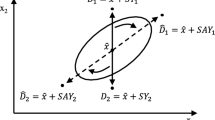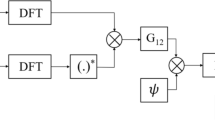Abstract
Linear frequency modulated (LFM) signal is used to describe radar echo signal, and Wigner–Hough transform (WHT) is a useful detection tool for LMF signals. The noise in radar echo signal has strong pulse under complex environment, which belongs to \(\alpha \) stable distribution process. The WHT method degenerates under \(\alpha \) stable distribution environment. Hence, fractional lower-order pseudo-Wigner–Ville distribution (FLO-PWVD) time–frequency method is introduced, and fractional lower-order pseudo-Wigner–Hough transform (FLO-PWHT) method based on the FLO-PWVD method and Hough transform is proposed for the detection of LFM signals. When the LFM signals are overlapped in time domain and generalized signal-to-noise ratio (GSNR) is relatively low, the FLO-PWHT method degenerate, even which cannot work. Therefore, fractional lower-order spacial time–frequency matrix is applied to substitute spacial time–frequency distribution matrix, and a new fractional lower-order spacial time–frequency underdetermined blind source separation (FLO-TF-UBSS) algorithm employing the time–frequency underdetermined blind source separation algorithm (TF-UBSS) is proposed in this paper. Also, we combine the FLO-PWHT method with the FLO-TF-UBSS algorithm and propose a fractional lower-order spatial time–frequency underdetermined blind source separation pseudo-Wigner–Hough transform (FLO-TF-UBSS-PWHT) method. The simulation results show that the FLO-PWHT method is obviously better than the existing PWHT algorithm under \(\alpha \) stable distribution noise or Gaussian noise environment, which is robust. The FLO-TF-UBSS algorithm can effectively downgrade mean square error of the reconstructed LFM signals, and its performance is better than the existing TF-UBSS and minimum dispersion BSS algorithms. The FLO-TF-UBSS-PWHT algorithm can work well in the cases of time domain overlapping and relatively low GSNR; its performance is better than the FLO-PWHT algorithm, which has certain toughness. Finally, we apply the FLO-PWVD, FLO-TF-UBSS, and FLO-PWHT methods to analyze and extract fault features of the bearing outer race fault signal in DE; the experimental results illustrate their performance superiority.


















Similar content being viewed by others
References
A. Abdeldjalil, L. Nguyen, A. Karim et al., Underdetermined blind separation of nondisjoint sources in the time-frequency domain. IEEE Trans. Signal Process. 55(3), 897–907 (2007)
S. Assous, L. Linnett, Fourier extension and Hough transform for multiple component FM signal analysis. Digital Signal Process. 9(16), 115–127 (2014)
J. Bobin, J. Rapin, A. Larue, J.L. Starck, Sparsity and adaptivity for the blind separation of partially correlated sources. IEEE Trans. Signal Process. 63(5), 1199–1213 (2015)
P. Bofill, M. Zibulevsky, Underdetermined blind source separation using sparse representations. Signal Process. 81(11), 2353–2362 (2001)
Z. Chen, X. Geng, F. Yin, A harmonic suppression method based on fractional lower order statistics for power system. IEEE Trans. Ind. Electron. 63(6), 1–1 (2016)
L. Cirillo, A. Zoubir, M. Amin, Parameter estimation for locally linear FM signals using a time-frequency Hough transform. IEEE Trans. Signal Process. 56(9), 4162–4175 (2008)
CWRU Bearing Data Center. http://csegroups.case.edu/bearingdatacenter/pages/download-data-file
A. Gualandi, E. Serpelloni, M.E. Belardinelli, Blind source separation problem in GPS time series. J. Geod. 90(4), 323–341 (2016)
A. Guo, X. Li, C. Samson See, LFM signal detection using LPP-Hough transform. Signal Process. 91, 1432–1443 (2011)
J. Han, Q. Wang, K. Qin, The non-stationary signal of time-frequency analysis based on fractional Fourier transform and Wigner–Hough transform. Lect. Notes Electrical Eng. 237(10), 1047–1054 (2014)
R. Kulkarni, P. Rastogi, Simultaneous measurement of in-plane and out-of-plane displacements using pseudo Wigner–Hough transform. Opt. Express 22(7), 8703–8711 (2014)
H. Li, Y. Zhao, Z. Cheng, D. Feng, Correlated LFM waveform set design for MIMO radar transmit beampattern. IEEE Geosci. Remote Sens. Lett. 14, 1–5 (2017)
L. Li, T.S. Qiu, D.R. Song, Parameter estimation based on fractional power spectrum under alpha-stable distribution noise environment in wideband bistatic MIMO radar system. Int. J. Electron. Commun. 67(67), 947–954 (2013)
L. Li, T. Qiu, X. Shi, Parameter estimation based on fractional power spectrum density in bistatic MIMO radar system under impulsive noise environment. Circuits Syst. Signal Process. 35(9), 3266–3283 (2016)
L. Li, T. Qiu, Parameter estimation based on fractional lower order statistics and fractional correlation in wideband bistatic MIMO radar system. J. Syst. Palaeontol. 4(3), 269–278 (2014)
N. Li, C.W. Qu, F. Su, D.F. Ping, A new mixed LFM signal recognition method. J. Signal Process. 26(2), 286–290 (2010)
N. Linh-Trung, A. Belouchrani, K. Abed-Meraim, B. Boashash, Separating more sources than sensors using time-frequency distributions. J. Appl. Signal Process. 17, 2828–2847 (2005)
X. Liu, C. Sun, Y. Yang, J. Zhuo, High-range-resolution two-dimensional imaging using frequency diversity multiple-input-multiple-output sonar. Iet Radar Sonar Navig. 10(5), 983–991 (2016)
F. Liu, H.F. Xu, D.P. Sun, Feature extraction of symmetrical triangular LFMCW signal using Wigner–Hough transform. J. Beijing Inst. Technol. 18(4), 478–483 (2009)
J. Long, H. Wang, Parameter estimation and time-frequency distribution of fractional lower order time-frequency auto-regressive moving average model algorithm based on \(S\alpha S\) process. J. Electron. Inf. Technol. 38(7), 1710–1716 (2016)
J. Long, H. Wang, D. Zha, Fractional low-order adaptive time-frequency distribution based on stable distribution noise. Comput. Eng. 18(9), 81–83 (2011)
J. Long, H. Wang, D. Zha, EEG-MUSIC source localization in \(\alpha \) stable noise environment. Comput. Eng. Appl. 49(2), 122–125 (2013)
J. Long, H. Wang, D. Zha, Evoked potential blind extraction based on fractional lower order spatial time-frequency matrix. J. Biomed. Eng. 32(2), 269–274 (2015)
F. Lu, Z. Huang et al., Underdetermined blind source separation (BSS): a time-frequency approach. Chin. J. Electron. 9(39), 2068–2072 (2011)
X. Ma, C. Nikias, Joint estimation of time delay and frequency delay in impulsive noise using fractional lower order statistics. IEEE Trans. Signal Process. 44(11), 2669–2687 (1996)
M. Ma, Y. Shen, Z. Kong, A detection method for LFM signals based on blind source separation and Wigner–Hough transform. J. Proj. Rocket. Misseles Guidance 27(4), 251–253 (2007)
S. Mohamed, A.M. Karim, B. Messaoud, Blind separation of impulsive alpha-stable sources using minimum dispersion criterion. IEEE Signal Process. Lett. 12(4), 281–284 (2005)
S. Mohamed, A.M. Karim, B. Messaoud, Blind separation of impulsive alpha-stable sources using minimum dispersion criterion. IEEE Signal Proc. Lett. 12(4), 281–284 (2005)
G. Qian, P. Wei, H. Liao, Efficient variant of noncircular complex FastICA algorithm for the blind source separation of digital communication signals. Circuits Syst. Signal Process. 35(2), 705–717 (2016)
S. Redif, S. Weiss, J. Mcwhirter, Relevance of polynomial matrix decompositions to broadband blind signal separation. Signal Process. 134, 76–86 (2017)
X.S. Ren, Y.H. Shen et al., Algorithm for mixing matrix estimation based on time-frequency analysis. J. Signal Process. 4(28), 545–553 (2012)
M. Shao, C. Nikias, Signal processing with fractional lower order moments instable processed and their applications. Proc. IEEE 81(7), 986–1010 (1993)
J. Su, H. Tao, X. Rao et al., Robust multicomponent LFM signals synthesis algorithm based on masked ambiguity function. Digital Signal Process. 44(9), 102–109 (2015)
B. Tang, Parameters estimation and detection of MIMO-LFM signals using MWHT. Int. J. Electron. 103(3), 439–454 (2016)
H. Wang, J. Long, D. Zha, Frequency spectrum estimate based on decomposed FLOC matrix under stable distribution noise. Appl. Mech. Mater. (556–562), 4563–4567 (2014)
H. Wang, J. Long, D. Zha, Pseudo Cohen time-frequency distributions in infinite variance noise environment. Appl. Mech. Mater. (475–476), 253–258 (2014)
H. Wang, J. Long, D. Zha, Modeling and parameter estimation based on FLO-TFMA. Comput. Eng. Appl. 51(20), 178–182 (2015)
Y. Zhang, P. Wang, S. Feng, P. Zhang, Design of adaptive millimeter-wave MIMO systems in rain scattering. IEEE Trans. Veh. Technol. 65(7), 5317–5326 (2016)
H. Zhang, G. Hua, L. Yu, Y. Cai, G. Bi, Underdetermined blind separation of overlapped speech mixtures in time-frequency domain with estimated number of sources. Speech Commun. 89, 1–16 (2017)
A. Zhang, T. Qiu, X. Zhang, Blind signals separation method based on fractional lower order moments. J. Commun. 27(3), 32–35 (2006)
X. Zhu, W. Zhu, B. Champagne, Spectrum sensing based on fractional lower order moments for cognitive radios in \(\alpha \) stable distributed noise. Signal Process. 111, 94–105 (2015)
Acknowledgements
This work is financially supported by Natural Science Foundation of China (61261046, 61362038), the Natural Science Foundation of Jiangxi Province China (20151BAB207013), the Research Foundation of health department of Jiangxi Province China (20175561), science and technology project of provincial education department of jiangxi (GJJ161083), and science and technology project of Jiujiang university China (2016KJ001, 2016KJ002).
Author information
Authors and Affiliations
Corresponding author
Rights and permissions
About this article
Cite this article
Long, J., Wang, H., Li, P. et al. A WHT Signal Detection-Based FLO-TF-UBSS Algorithm Under Impulsive Noise Environment. Circuits Syst Signal Process 37, 2997–3022 (2018). https://doi.org/10.1007/s00034-017-0703-6
Received:
Revised:
Accepted:
Published:
Issue Date:
DOI: https://doi.org/10.1007/s00034-017-0703-6




